Some people get a sudden rush after reaching the peak of exhaustion when performing any sort of strenuous physical activity. If you’ve experienced this, you’ve probably felt as though all the tiredness goes away and you can continue what you’re doing for a good while longer.
This phenomenon is sometimes called a runner’s high or second wind. Apart from the stamina boost, it also masks pain and other discomforts. A feeling of euphoria also comes with the package for some individuals.
In BDSM, particularly with submissives or subs, the equivalent of a runner’s high is referred to as the subspace. The two have a lot of similarities. But, of course, the road to reaching the subspace is much different from that of a runner’s high.
Subspace is quite complex. It involves extreme emotional and physical sensations, which may confuse or even terrify the uninitiated. It’s a product of an intense scene involving particularly potent kink plays. As such, it carries some pretty heavy risks.
Understanding subspace means breaking down the science, specifically the chemistry, behind it. There’s not much of it as of yet. But what little research there is says a lot about the whats, hows, and whys of subspace. They may also help you decide whether or not reaching it is for you and your partner.
Identifying Subspace During BDSM Play

The subspace experience is different for every submissive. The singular subspace “feeling” is the result of a multitude of physical, emotional, and psychological sensations bombarding the body and mind in unison.
During the height of a scene, the sub or bottom may feel some telltale signs that signal that they’ve stepped on this awesome plane.
1. Euphoria
You know that feeling of extreme excitement and joy when you just heard some really good news? It’s like everything is right in the world. Negative vibes just rush out of your system with little to no effort. That’s euphoria.
This incredibly pleasing mindset is one of the most common symptoms of subspace. You feel happy and content despite being in the middle of a spanking session.
It’s a tremendously addictive aftereffect, making it one of the main driving forces behind why many BDSM couples devote considerable effort to reaching the subspace.
2. Incoherence and inability to articulate

If you watch a lot of porn—and let’s be honest, you do—you might notice some rather questionable reactions from the bottom. In some rough sex scenes, they will have a dazed look in their eyes, like the lights are on but nobody’s home.
This is often coupled with illogical responses and a load of cry-mumbling and gibberish talk. We can chalk it up to bad acting but there’s a good chunk of truth in it as far as subspace is concerned.
The pleasure brought on by certain kink plays reaches such incredible heights that the sub’s mental faculties degrade to seemingly worrying levels. This is why many people liken the subspace to being really drunk or high.
If you’re a Dominant, don’t expect your sub to make intelligible, impassioned speeches about the impermanence of life while in this altered state.
3. Physical weakness
When you’re tripping out on pleasure, once the mind goes, the body soon follows.
Weakness and sleepiness are two of the common physiological effects of simmering in the subspace. Knees turn to jelly and muscles tremble.
Again, going back to porn, you might see some scenes where the bottom is struggling to hold their head up despite being fully awake. In real BDSM, exhaustion might play some part in it but, if the sub has crossed over into the subspace, it’s mostly the “high” that causes these physical effects.
4. Energy boost or hyperactivity

Just as you may feel spent, you have an equal chance of getting an energy boost while in subspace. This particular effect has much to do with the body’s emergency response mechanisms.
You might feel short bursts of feeling caffeinated. Hyperactivity is also associated with this symptom.
5. Increased pain tolerance and dissatisfaction
A sub that’s deeply entrenched in the subspace may get the feeling that pain no longer causes them discomfort. This happens after the initial agony of being subjected to certain kinks, such as impact and torture plays.
Once the subspace kicks in, thresholds to certain acts might get warped and tolerance levels move up to significant levels. If this happens, the sub might ask for more punishment to feel more pain.
This dissatisfaction can also make the sub feel like they’re primed for other BDSM adventures in the middle of the scene, increasing their openness to suggestions. They may consider activities that are not on the session’s to-do list.
This can trigger drastic behavioral changes in the sub as well. They may act substantially more sexy or extra subservient to goad the Dom for more rewards or “funishment”.
6. Out-of-body experience

Some submissives get a feeling of “floatiness” and detachment. This causes them to seemingly part from reality or even waft away from their physical form.
During this psychedelic episode, the sub may feel as though they’re flying around the room. Other subs say that they can even watch themselves and their partners as they do the scene in these out-of-body experiences.
A strong sense of losing control—one that differs from being in a Dom/sub dynamic—also envelops them while in this dream-like state. This sensation is often considered a positive thing.
How Intense Feelings Trigger the Subspace
Hormones.
Indeed, the subspace is a product of the body’s attempt at bartending. Actually, it’s more like a fireman frantically dousing the effects of an intense BDSM scene with buckets of hormones.
Our body is constantly communicating with us through various channels. When a scene gets too intense, it assumes that it’s in grave danger and prompts a sympathetic nervous system response. Different glands then release squads of hormones as countermeasures to what we’re being subjected to.
Let’s look at the main players in this wild and sexy game of chess.
1. Adrenaline
Also known as epinephrine, adrenaline comes from the adrenal glands. It’s famously known for being the “fight-or-flight hormone.” Danger, excitement, threats, and stress—these are the most common triggers for increased adrenaline secretion.
The body might read particularly “spirited” BDSM plays as serious attacks. The hormone in question provokes several physical effects to increase your reaction time, hence, the fight-or-flight response.
The heart rate goes up, and blood flow to the brain and muscles increases. Sugar production also rises. As a result, you’ll feel a sudden energy boost.
If your kinky play is intense enough, it might trigger an extremely large and fast surge of epinephrine. This is what’s called an adrenaline rush. The massive hit from a rush will also hasten physical effects. Everything can happen so quickly that it might confuse you.
The energy bump and the perplexed mental state the hormone leaves you may contribute to the feeling of euphoria and a natural chemical high. And, since adrenaline is a stress response, it also heightens pain tolerance.
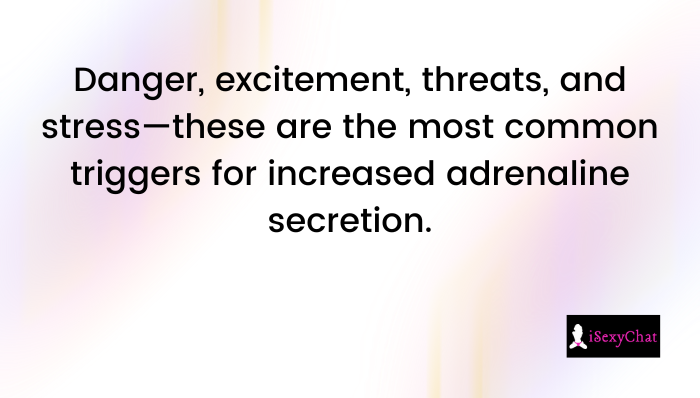
2. Endorphins
Endorphins are a group of natural chemicals that the body releases in response to stress and pain. Say you’re a sub in an S&M (sadomasochism) session and the paddling gets turned up to 11, endorphins rush out to curb pain.
The effects of endorphins are often compared to those of morphine for the certain kind of high they produce. But unlike synthetic opioids, natural endorphins, even at notably elevated levels, are largely considered safe and healthy.
Activities such as meditation, exercise, and laughing prompt endorphin production. Eating spicy foods and dark chocolate also encourages the same effect.
In BDSM terms, apart from pain, the act of giving also triggers the release of these hormones. “Giving” in this sense is the sub’s relinquishing of control to their Dom. The fact that they’re making their Master happy gives them happiness thanks in part to endorphins.
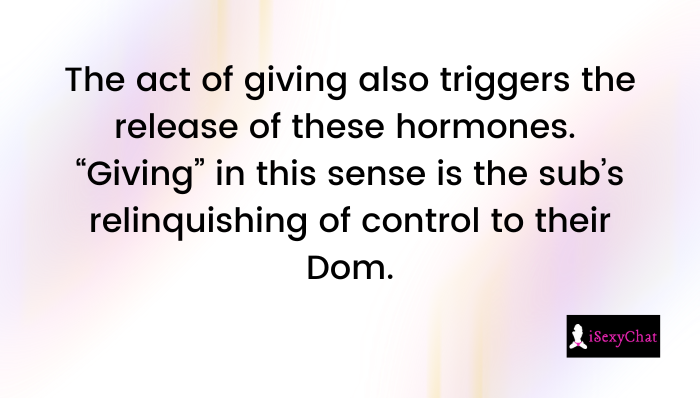
3. Cortisol
Cortisol works about the same way as adrenaline does. They’re both fight-or-flight, pain, and stress hormones. They’re even produced in the same gland. But the two are chemically distinct. Cortisol also has other tricks up its sleeve.
Apart from the ones mentioned, cortisol also affects injury recovery, immunity, metabolism, and blood pressure regulation. Like testosterone and progesterone, cortisol is a steroid hormone.
Prolonged high levels of cortisol are responsible for a good number of negative effects, such as heart disease, weight gain, and blood sugar imbalance, to name a few. But don’t worry. The body is very much aware of these consequences and heavily regulates cortisol levels.
Steroid hormones have the reputation of making things run wild. Thankfully, a healthy body levels out excess cortisol production not long after the subspace.
Cortisol is a stress hormone by nature. But within the controlled environment of the scene, it plays some part in bringing about a trance-like state if you hit the subspace.
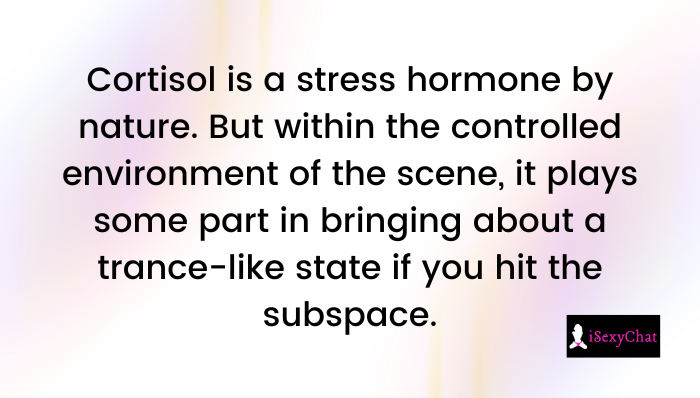
4. Dopamine
Dopamine goes by a few street names, such as pleasure hormone and feel-good hormone. It’s a neurotransmitter that sends messages between your brain, nerve cells, and the rest of your body.
This chemical is also known as the reward hormone. Dopamine is released when we’re doing instinctive survival activities, such as eating and drinking. Our bodies reward us for taking care of it through dopamine hits.
Reproduction and other acts that lead to it are also powerful dopamine triggers. Again, it’s our reward for going with one of humanity’s most basic instincts—procreation.
Outside of practical evolutionary stuff, we get dosed with dopamine when we do things that we like. That’s why pretty much everything we do is subconsciously geared toward releasing dopamine into our system.
Its role in psychological subspace and sexual activities in general is straightforward. If we like having sex then we get dopamine.

5. Oxytocin
Oxytocin goes hand-in-hand with dopamine. Also known as the sex, love, or romance hormone, this chemical messenger plays a huge role in sexual arousal and romantic attachment.
In its more “innocent” capacities, oxytocin is a social hormone—partly responsible for trust recognition and development as well as mother-and-child bonding.
Positive physical contact also causes oxytocin release, which is why it’s also referred to as the “cuddle chemical”. Hugs, massages, handshaking, and even playing with pets trigger oxytocin production. During sex, it amplifies the pleasure we feel during orgasm.
Unfortunately, oxytocin also tends to intensify bad memories of social and familial relationships. And just as it fosters trust, it can also initiate trust issues toward other people.

“Why Am I In This Altered State?”

Almost all the hormones produced on the way and while in the subspace are fight-or-flight responses. During this time, our senses are heightened and more energy is produced to fuel either an oncoming “battle” or the escape to safety.
When the body is in survival mode, it conserves resources by partially or completely shutting down other systems and functions. This is one of the reasons why you may feel like you’re in an altered state or a different zone from the rest of the world while in the subspace.
Within an actual scene, the Dominant and the nature of the kink have a large influence in triggering the subspace. In a 2009 study, female participants were subjected to common S&M-level stimulation, such as bondage, sensory deprivation, and various pain plays. Usual verbal and non-verbal Dom/sub activities like getting ordered around also came into play.
Positive reinforcement like expressions of affection and other pleasurable measures were also used. The subs who enjoyed certain kinks showed a notable increase in their cortisol levels. Additionally, couples who expressed appreciation of the experience also reported feeling closer to each other after the tests.
The Doms didn’t register any noteworthy activities concerning their hormonal levels. This means more research is definitely needed to understand how BDSM affects both participants and not just the submissives.
However, the study, such as it is, had displayed that consensual BDSM plays do have direct effects on the body’s chemistry as well as on the degree of intimacy between practitioners.
Inducing Sub Space

The process of bringing about the subspace is extremely subjective. It requires a laundry list of factors that BDSM couples can’t possibly piece together accurately and deliberately. In short, it just happens, for the most part.
Some submissives say that the more you want the subspace, the more elusive it gets. We’re delving into psychological territory if we’re going to take said notion with any level of sincerity. Does that mean you shouldn’t want the subspace to increase the probability of it happening? It’s hard to tell because one sub is different from another.
Fortunately, between the study mentioned above and the research behind the runner’s high, we already have some science to lean on. They’re all we have right now but we make do as we always have.
Many BDSM experts suggest going straight for the main hormonal triggers: stress and pain. More pain is the order of the day if you’re keen on somewhat determining the subspace entry point. Start slow and steady. Consider the risks, first and foremost, especially if you’re a bit of a stranger to pain kinks.
Most S&M plays already have a template for gradually intensifying pain within a single session. Impact play is a go-to practice for triggering survival responses and the hormones that go with them. Start with light spanking and work your way from there in steps.
Intermittent pain administration may also set the stage for subspace. Taking very brief breaks between different pain intensities gives the sub’s body time to respond to the stimuli. It also allows subs to realize their thresholds with some level of accuracy.
Continuous paddlings that get stronger and stronger are counterintuitive to your “research”. Plus, it’s generally bad for an inexperienced sub.
As for inducing stress, if impact play isn’t enough, you have a few potentially helpful strategies. Breath play is a good starting point. There’s nothing quite as panic-inducing as being deprived of precious oxygen. If some erotic asphyxiation doesn’t do it, turn the dial up with simulated drowning.
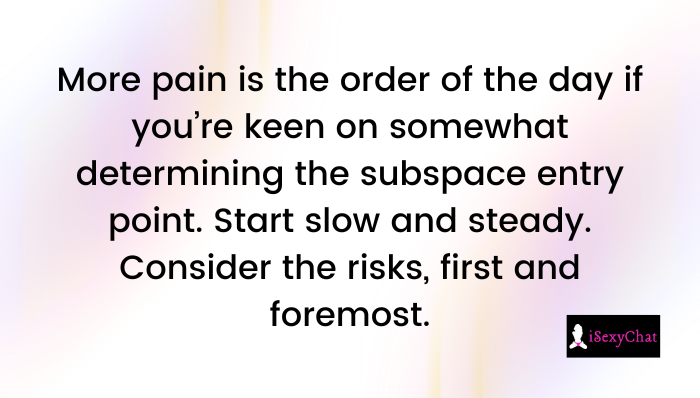
If extreme stress is what you’re looking for then consensual non-consent (CNC) scenarios are hard to top. If you’re not familiar with this kink, it’s basically extreme societal taboos incorporated into BDSM scenes. Rape play is the most well-known example.
Creating an elaborate atmosphere of helplessness, fear, and panic through simulated sexual assault is incredibly visceral. In a pretty solid way, the body’s fight-or-flight response to CNC is very much warranted. It would be hard to believe that someone won’t get at least some hormonal reaction to this type of kink play.
That said, breath play and CNC are quite advanced kinks and only the sane, educated, experienced, and well-prepared should engage in them.
We should note the upsetting fact that some subs never reach the subspace irrespective of their efforts. On the other hand, others don’t require intense emotional and physical stimulation for reaching this much-coveted state. It’s vital that, if you’re aiming for the subspace, you also prepare yourself for the gut-punching realization that it’s possibly an unattainable goal.
For Doms, causing physical pain and putting the fear of God in their subs while keeping them horny is a tricky order. But with trust, proper preparation, and very open and honest communication between partners, it’s a doable task. Of course, always ensure consent first and make safety your top priority. And mind your safe word!
Non-Physical Triggers and Self-Induced Subspace

With couples in a committed relationship, non-physical triggers work just as well as a good spanking. Particularly for people who are crazy for each other, distant gestures can bring a sub the subspace or closer to it.
Emotional bonds and strong sexual desire are the main players in these hormonal prompts. Yes, boys and girls, good old lust can trigger a survival response.
A seductive wink, talking in a commanding, non-aggressive tone, and so on may send the sub into an underwear-changing spin from all the “happy juices” circulating in their veins.
Some submissives purposely or inadvertently bring themselves to the subspace on their own. Just thinking about the Dom—how well they do their job as relationship head or simply how attractive they are—can bring forward powerful sensations.
Anticipation for an upcoming session can also cause the same effect. A not-so-low-key trigger is looking at a partner’s nudes. It’s on the nose, yes, but it gets the ball rolling toward subspace for some people.
Subspace intensity from zero-contact stimuli varies. Some go into a sort of “subspace light”—a state where they’re still quite functional. Others go into full fits of incoherence and toe-curling pleasure. It’s an interesting facet of BDSM relationships, which you should look into if you’re seriously exploring subspace triggers.
Here Comes the “Drop”

Excesses are expensive. The subspace’s payment terms require a deposit, which is the pain and stress needed to trigger it. And after the “service” has been rendered, it will reach its sweaty palms out for the rest of the fee. And that’s the sub drop.
In a nutshell, sub drop is the crash when all those lovely hormones leave your body. It’s a perfectly normal reaction to the gradual or drastic change in the body’s chemistry.
Coming down from the subspace’s high comes with an assortment of symptoms. Every sub experiences sub drop differently but here are several common items that you may find in the subspace’s “Thank you for coming” basket.
- Physical and emotional exhaustion
- Hunger and thirst
- Moodiness and hostility
- Depression-like symptoms
- Body pains
- Detachment or aversion to any form of interaction with the Dom
- Dizziness and nausea
A drop’s timing varies. You may get it immediately, a couple of hours, or even days after a scene. The rate at which the body metabolizes the cocktail of hormones is the main agent of this process.
A sub drop’s length and severity are also difficult to anticipate. It may rely on the intensity of the play and the resulting subspace. The sub’s state of mind and body before entering the scene are also known factors that either mitigate or aggravate this post-scene phase.
Some submissives don’t get sub drops at all for whatever reason. In the interest of safety, it’s always best to assume that you’ll get it.
Perhaps the most effective weapon against the drop’s adverse effects is proper aftercare. It’s something any BDSM practitioner should know before even planning out kink plays.
What is Aftercare?

As the name suggests, aftercare is a series of post-session practices aimed at minimizing or eliminating the effects of sub drop. Drops can be traumatizing experiences if not treated or approached correctly and with finesse.
Standard BDSM practice calls for having an aftercare kit on hand for every session. A must-have in this care package is a first-aid kit for treating wounds, abrasions, and bruises. Addressing injuries incurred from the scene should always be first on your aftercare list.
Other usual inclusions are replenishments (food and water), blankets, and a fresh change of clothes.
Another primary purpose of aftercare is for easing the sub or bottom’s emotions and mind down from the rush. A particularly intense BDSM scene may leave them feeling unsafe. So preparing things and activities that will take their mind off any sort of negative feelings is also a crucial aspect of aftercare.
Board games, books, cuddling, and a reassuring chat are excellent ways to bring a sub back to reality and make them realize that they’re in a safe space.
Aftercare strategies are highly customizable. Apart from practical treatments, a bespoke aftercare experience will make the sub feel that they’re truly valued and cared for and that the harshness of the scene is all just part of the play. They must remember that nothing in it is genuine abuse.
Given that the sub is largely incapacitated during sub drop, administering aftercare largely falls on the Dom. They must look after their sub until they regain balance. Lavishing the sub with generous attention and luxurious gifts and treats is not an uncommon practice for an especially caring Dom.
In the case of a delayed drop, the sub must also learn self-care techniques since the Dom probably won’t be around for them.
Going down from the subspace’s blissful green to the sub drop’s ravaging red zone is indeed a shocking event. Proper aftercare is there to ensure that the effects won’t leave any lasting or permanent effects on the sub.
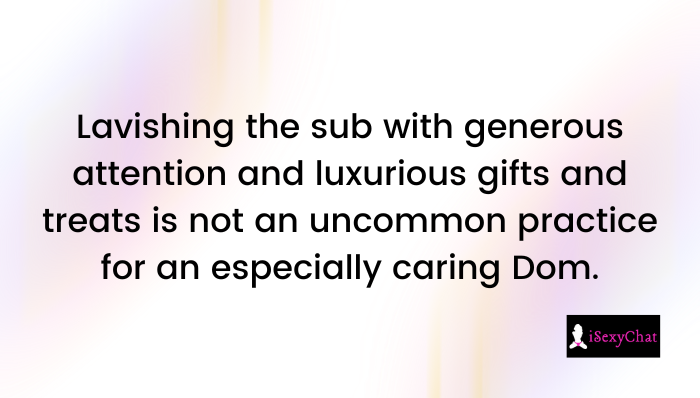
Dangers of Subspace
There’s no other way of putting it. BDSM, as a whole, is dangerous. You’re tempting fate with risky activities that involve inflicting or receiving pain—physical or otherwise—for pleasure.
If you’re the sub, you might assume that you’re out of the woods when you’ve reached the subspace. After all, it’s the part of the session where you reap your rewards for taking the brunt of an intense scene. And the sub drop is just par for the course and something the Dom should worry about, right?
The truth is the subspace itself poses a few dangers of its own. And they can be as hazardous as any of the riskiest kink plays known to BDSM.
1. Safe word issues
Remember when we said that you might lose the power of language whilst in the subspace? When communication skills go out the window, the safe word goes with it, unfortunately.
The Dom might not recognize that you’ve reached your limit despite the increased pain tolerance from being in the subspace. And this will often lead to serious injuries, like breaking skin from flogging or serious burns.
You might try your absolute best to invoke the safe word but all that comes out is garbled nonsense. Your Dom might just mistake your attempts at speaking for signs of intense pleasure or requests for more punishment.
2. Losing touch of pain thresholds
Those subspace hormones make you feel good. But sometimes they make you feel too good that the concept of pain becomes merely a suggestion.
An overabundance of anti-pain hormones can definitely override tolerances to extremely dangerous levels. Your pain threshold might reach such incredible heights that, before you know it, you’re black and blue all over from asking for more spankings.
3. Having an inexperienced Dom
You can avoid the two previous concerns by engaging in a scene with a Dom who knows what they’re doing.
An inexperienced Dom may fail to recognize that their sub has already reached the subspace and will probably just continue to wail on them since the safe word hasn’t been uttered yet—not knowing their sub’s limits is also a sign of a subpar Dom.
The subspace is meant to be enjoyed. A Dom who doesn’t know this will likely distract the sub by continuing the intense play instead of leaving them to relish the moment.
Some might just even end the scene as their sub is writhing in pleasure. They’ll start cleaning up or looking down at their phone. An unsupervised submissive who’s in the subspace zone might injure themselves as they flounder about on their own.
A properly learned Dom knows the physical and verbal signs of the subspace. And most importantly, they know when to stop. They’ll also look after their sub while they’re delighting in the effects of the subspace.
Craftier Doms know how to deal with subs who are begging for more pain as well. They’ll switch to milder impact play implements and use gentle love taps on less tender areas.
Some will simply mime hits and not make any actual contact. Odds are the sub is too enmeshed in the subspace to notice that they’re not actually getting spanked or whipped.
4. Having an abusive Dom
Casual BDSM partners are hit or miss. Sometimes you get a playmate who simply doesn’t live up to your expectations. There’s also a chance you’ll meet an opportunist or abuser in disguise.
It’s an awful truth. There are people out there who weasel and con their way into the BDSM community just so they can lay down legitimate violence and hatred onto other people. They pose a very serious threat to subs who don’t know any better.
These are the kinds of people who think that consent gives them a free pass to do absolutely anything and will not respect limits and safe words.
In the initial steps toward achieving subspace, these fake Doms will relish beating down on poor subs. Abusers are often very skilled manipulators as well. They can convince a sub to continue with the punishments and pain even if the latter has reached their limits.
These actual sadists—people with the personality disorder and not those who partake in consensual S&M kink plays—may use a variety of tactics for making partners submit to their will. They may bully and brute force their way to dominance. They’re also not above using positive reinforcement—a true sign of psychopathy.
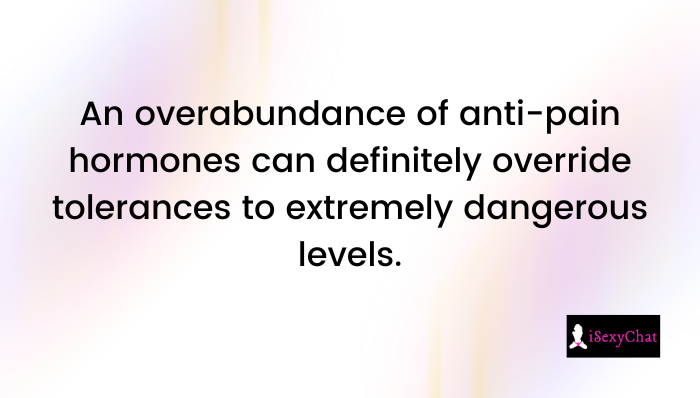
A submissive in the subspace is also incredibly agreeable and easily bent. This gives an opportunist a very large window for their misdeeds.
An abuser may also exploit a sub’s disabled state while in the subspace. They’re virtually free to do anything to their defenseless partner. Rape play that’s not part of the plan and done to an unwilling partner is just rape.
What these abusive types are capable of is nothing short of hair-raising. Recognizing the red flags before doing anything with them is key.
When negotiating the finer details of your Dom/sub relationship, you’ll notice that they’re all, “Me! Me! Me!” The terms they’ll pitch are brazenly one-sided and very little, if any, go toward the sub’s needs, wants, safety, and general well-being.
They’ll frequently contest the sub’s limits and boundaries. It’s also common for them to reject the idea of socializing with other people in the kink community. If you detect that they’re actively driving a wedge between you and your friends and family, you need to end the relationship posthaste.
Save yourself the trouble and only engage in advanced and intense plays with someone you completely trust. No one will fault you for first preferring light BDSM or going into a relationship with someone who classifies themselves as a soft Dom.
Know your partner well and then move on to kinkier, more fiery stuff. You’ll enjoy the pleasures of the subspace more with the affirmation that, while you’re in it, you’re with someone who is sane and has your best interests at heart.
Conclusion
Getting to the subspace is quite the mission. It’s a taxing journey of emotions and physicality that requires full understanding from the people who yearn for the most profound of sexual pleasures.
With adequate research and proper communication, you may just tap into the subspace successfully and, more importantly, safely. If your efforts fall short of achieving this goal, know that, for its strong emphasis on privacy and intimacy, you’re never truly alone in the BDSM lifestyle.
Help and experiential information are just around the corner. Reach out to in-person and online BDSM communities for assistance. Swap stories and compare experiences. From your interactions with other kinksters, you’ll determine what you’re doing right and which areas need work. So get yourself out there and explore. You and your partner will thank yourselves.





